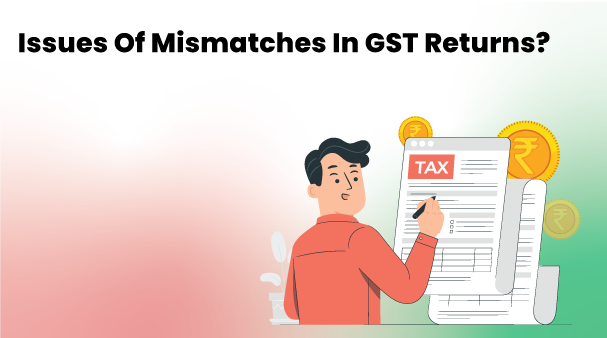How to File GST Return Online for Taxpayers in India?
The GST returns are indeed an important job for taxpayers, but here is how you can file your GST return without any confusing or laborious process. One easy method to file your GST return is the goods and services tax network, commonly known as GSTIN.
For the online Gst return Filing process, you can refer to this step-by-step guide.
- Visit the website www.gst.gov.in.
- You will receive a 15 digit number according to your state code and PAN number.
- You have to upload each of your invoices, and in return, a reference number will be issued for each invoice.
- Now comes the part where you file your cumulative monthly, inward, and outward returns. This is the part of mostly occurring mismatches.
- Your outward supplier returns are filed in GSTR-1, and the suppliers file your outward supplies in their GSTR-2A.
- The inward supplies are filed in GSTR-2.
What causes GSTR Mismatches in GST Return filing online?
A GSTR 1 and GSTR 3B mismatch can happen due to:
● If there is an issuance of debit notes or credit notes
● Sales Invoice Amendments
● Improper filing of invoices in GSTR-1 and 3B
However, there are amends for rectifications of the mismatches.
What if the mismatch cannot be rectified or if the return remains pending due to mismatch?
There are certain steps to rectify the mismatch in your GSTR, you can apply for a rectification online, and if there is any excess tax you pay, you will get a refund effectively. However, if you still have any issues and cannot rectify your mismatches, you can file an online request again for the particular issue with updated information if there was any incorrect information.
What are the consequences of GSTR mismatches?
A GSTR mismatch can result in a recovery action for any hidden sales. These mismatches are often seen as a higher return in GSTR-1 and a lower return filed in GSTR-3B. Usually, these practices are followed to claim the input tax credit and save tax further by filing a suppressed sale in GSTR-3B.
These activities result in consequences like show causes notices preceded with a recovery process. However, recent amendments have introduced section 75 in the GST Act. This enables the authorities to initiate recovery without any show-cause notice.
Here are the top 10 mistakes taxpayers usually make that you should avoid while filing your invoices for a hassle-free business.
1. Incorrect invoice information
Whenever you find your invoice, the matching mechanism of the GST portal auto-populates your GSTR 1 details and data into GSTR 2A. A missed entry in filling GSTIN will prevent the recipient from reflecting at their end in GSTR 2A.
2.Common mistakes of filling wrong sales information
The motive of filing returns is to get a refund. There are two types of refunds. The first one is a refund paid for the tax at the time of export, whereas the second one is paid on the tax of input credits. Most taxpayers mistake filing these returns, which leads to a mismatch.
3.Intrastate and interstate supplies
The interested state and interstate tax are separate on both businesses. Most business owners are not quite familiar with the section of their income while filing the return. To avoid a mismatch, you should make sure you file the interstate and intrastate separately and in their correct section.
4.GSTR 3B and 2A mismatch
GSTR 2A reconciliation is the second most important reconciliation. It has been seen that few taxpayers hide ITC reversal in 3B return. This may lead to questioning from the income tax department for ITC non-reversal. You should avoid any mismatch in GSTR 3B and 2A to get faster returns.
5.GSTR 3B and GSTR 1 mismatch
The miss-match for GSTR 1 and GSTR 3B happens for three main reasons: disclosed invoices that lead to a mismatch in GSTR 1 and 3B. Tech squares usually practice these activities to reduce their output liability by reducing their sales. They seek this as an escape from paying timely taxes.
6.Confusion with no supply and exempted supply
The no supply and exempted supply are two different things. No supply is not a taxable supply, and there is no need to report this in your return invoice. Most taxpayers mistake misplacing exempted supply and no supply, which leads to a mismatch in GST.
7.Input Tax Credit adjustment issues
Issues in input tax credit adjustment are among the most common mistakes most taxpayers commit while filing GST returns. This should be done by following a mechanism to adjust the input tax credit properly. This mechanism includes the first step in which IGST is exhausted, and with the remaining amount, CGST and SGST are utilised. However, you can adjust IGST from any of these three, but SGST and CGST can be adjusted from their own payable only.
8.B2B and B2C supply issues
B2B and B2C supply need to be filed separately, and here the taxpayers make mistakes by filling them either interchangeably or altogether. This is one of the most noticeable mistakes in the return filing process.
9.Non-submission mistakes of final return
When a taxpayer with a cancelled GST registration files the return through GSTR 10, it is referred to as a final return. This return is a must filed within three months from surrender or cancellation. Failing to do so has consequences of penalty and interest.
10.Advance payment reporting mistake
Most taxpayers mistake not filling the advance payment they receive until the full payment is made. This usually results in a mismatch of the returns. To avoid delays in getting returns, you must file your advance payment on time.
Wrapping up
GST returns are filed to get returns on the tax paid on business income that lies under the taxpaying category. A timely filed return always helps, and there are options for GST monthly return filing to ease the process and eliminate the chance of mismatch or any error. Still, the taxpaying community feels flooded with several problems, and mismatches are one of them. There are several softwares nowadays, and every taxpayer can choose the Best GST software for return filing according to their requirement to get hassle-free filing and quick returns.

